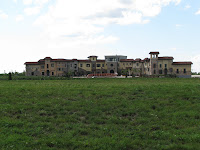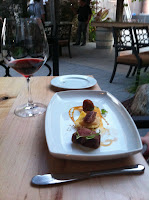 This is my third visit to Colaneri Estate Winery, as I wanted to make sure I was giving it a fair chance. We didn't have a great experience on our first visit, but when I stopped by with some friends a few months later, there had been some improvements. For example, the construction on the villa was far enough along that they could set up a separate tasting area for festival events. That visit also gave us the chance to speak with one of the owners, who told us more about her family, the winery, and its unique series of wine labels, each representing one of her relatives.
This is my third visit to Colaneri Estate Winery, as I wanted to make sure I was giving it a fair chance. We didn't have a great experience on our first visit, but when I stopped by with some friends a few months later, there had been some improvements. For example, the construction on the villa was far enough along that they could set up a separate tasting area for festival events. That visit also gave us the chance to speak with one of the owners, who told us more about her family, the winery, and its unique series of wine labels, each representing one of her relatives.
Keep in mind, Colaneri is one of the highest priced wineries in the region, with prices very similar to Tawse, which, I must admit, I find a little nervy, since it implies the wines are of equal quality. This festival gave me the opportunity for a direct comparison, since Colaneri was serving its 2010 Cabernet Franc, and I am very familiar with the Tawse equivalent. A unique feature of this wine is that it is produced using the apassimento method, meaning that, in this case, 30% of the grapes have been dried before pressing, resulting in a higher concentration of sugar and flavours. I have heard various opinions as to whether or not this is a luxury, since the time and labour intensive process results in lower yields, all of which raise the price of the wine. Others insist that good grapes in the correct climate shouldn't need artificially aged, explaining why the process is popular in northern, as opposed to southern Italy. Anyway, if you have any knowledge of the topic, I'd appreciate your comments.
 This is one of the nicest smelling wines I've ever tried. The easy to find nose begins with bell and roasted peppers, and possibly dried tomatoes. As the wine aerates, cedar, eucalyptus and cocoa are all detectable. Unfortunately, the taste does not live up to the beautiful complexity of the smell. It is quite dry, and even a little chalky, possibly suggesting its youth. (Keep in mind this was the release date for this wine.) Chris noted he could taste the alcohol, but only barely. The mouthfeel is also somewhat thin for a cab, even a franc. It did pair nicely with the accompanying lasagna though, and earned an rating of 85 from us both, making it the best wine of the day, but falling short of the expectations set by both Tawse and Peller for this varietal.
This is one of the nicest smelling wines I've ever tried. The easy to find nose begins with bell and roasted peppers, and possibly dried tomatoes. As the wine aerates, cedar, eucalyptus and cocoa are all detectable. Unfortunately, the taste does not live up to the beautiful complexity of the smell. It is quite dry, and even a little chalky, possibly suggesting its youth. (Keep in mind this was the release date for this wine.) Chris noted he could taste the alcohol, but only barely. The mouthfeel is also somewhat thin for a cab, even a franc. It did pair nicely with the accompanying lasagna though, and earned an rating of 85 from us both, making it the best wine of the day, but falling short of the expectations set by both Tawse and Peller for this varietal.
















































